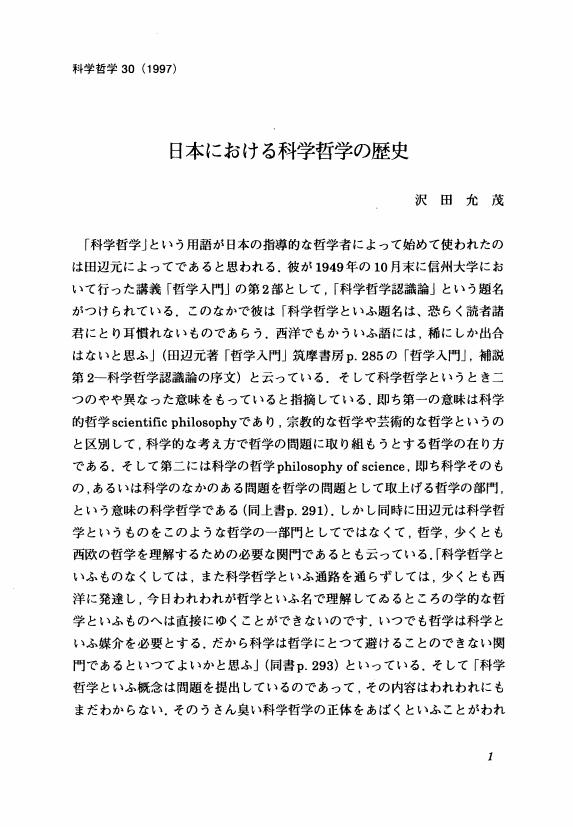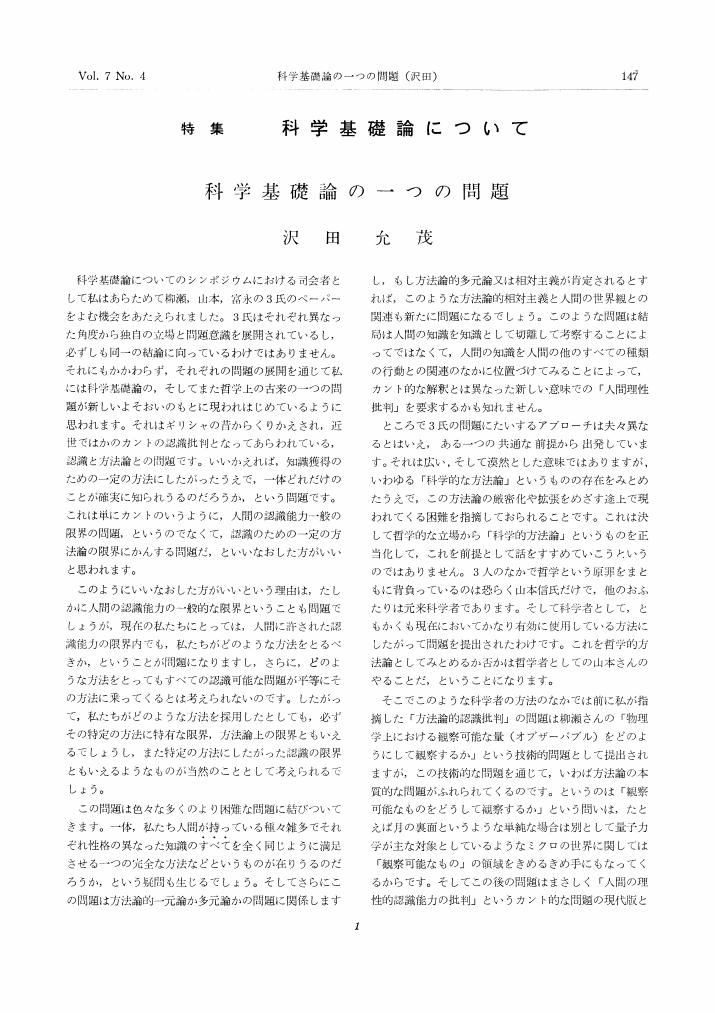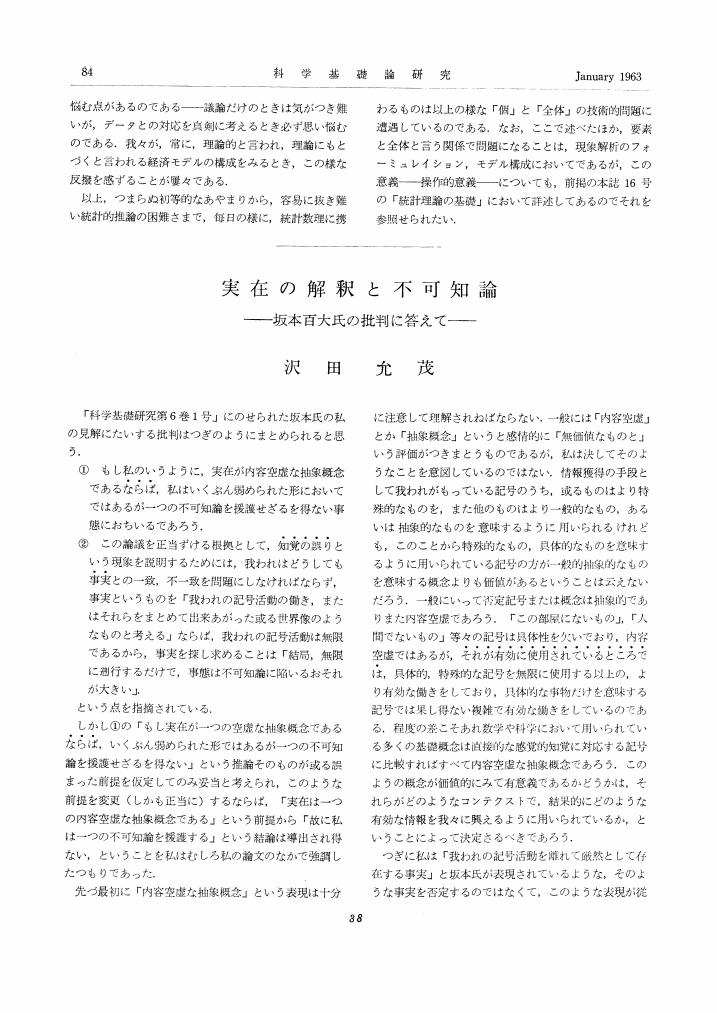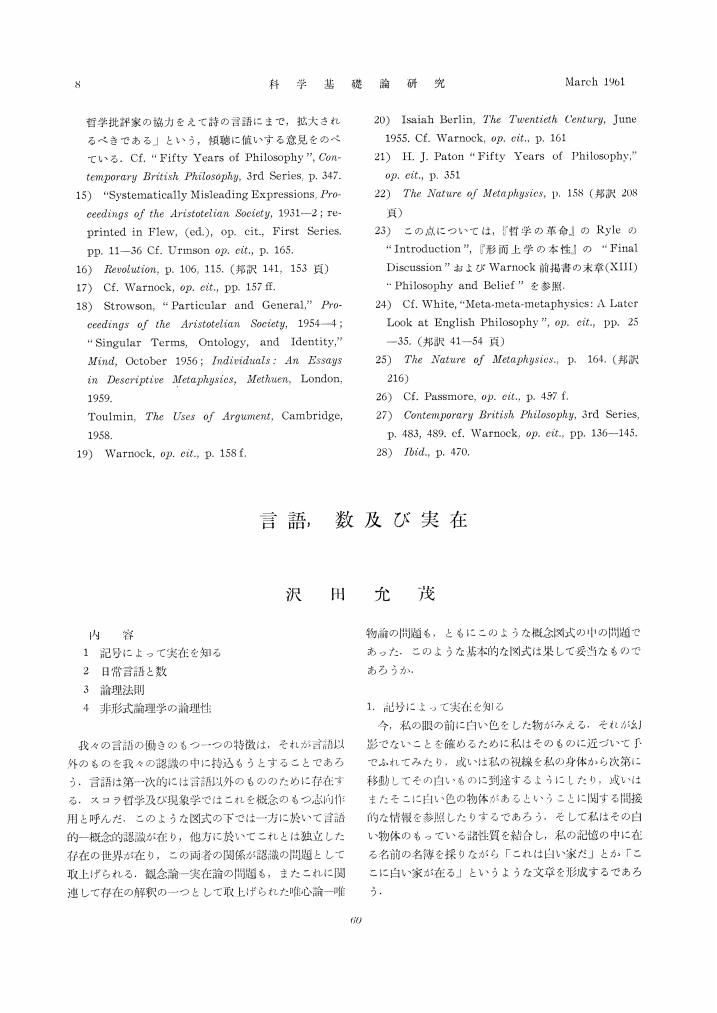18 0 0 0 IR 同一律、矛盾律等の異なった表現の仕方とこれに関連する哲学的立場に関する考察
- 著者
- 沢田 允茂
- 出版者
- 三田哲學會
- 雑誌
- 哲學 (ISSN:05632099)
- 巻号頁・発行日
- no.35, pp.121-139, 1958-11
伝統的論理学では論理学の最高原則又は原理として同一律、矛盾律、排中律等を挙げていることは衆知の事実である。しかし同時に現代の数学的論理学に於いてはこのような原理は唯一の公理の組ではなくて、せいぜい他の多くの論理規則の中の二三のものとして加えられるに止まり、従って論理学の原理とか原則などと云う概念そのものさえ余り用いられていないことも明かなことである。しかし過去の多くの哲学体系の中には明瞭に同一律、矛盾律、排中律等の論理学の原理が哲学の出発点となっている場合が多いし(例えば肯定的な意味ではフィヒテ、否定的な意味ではヘーゲルを挙げることが出来るであろう)、又論理学と対象界との関係が問題になる場合にはある意味に於いて右の原則の解釈が中心的な地置を占める場合が多い。従って右の原則は論理学プロパーの問題に属すると云うよりはむしろ認識論的な議論に属すると見ることが出来る。しかし従来それらがいはゆる論理学の原理と考えられていた所に実は論理学と認識論との、はっきりと区別し難い哲学的問題が指摘され得ることも見逃すことは出来ない。この小論文では(1)これらの原則の論理学内に於ける表現の仕方自身がすでにある哲学的、認識論的立場を先取していること、(2)これらの原則のある特定の解釈から生じている哲学的立場の批判、及び哲学的、認識論的問題として如何にこの問題を解決すべきかについての或る意見を述べることとする。There are altogether five different ways of expressing the so-called principles of logic. They are: a) term-expessions A is A, A is not non-A etc. b) propositional expressions {1) syntactical form p⊃p, -(p・-p) etc 2) semantical form "p" is true⊃"p" is true -("p" is true・"-p" is true) c) predicate-expressions {1) syntactical form (x)(px⊃px), (x)-(px・-px) 2) semantical form (x)("p" is true of x⊃"p" true of x) (x)-("p" is true of x・"-p" is true of x) etc. The history of logic shows that the term-expressions of these principles do not belong to the original aristotelian logic but originate in the late 15 cent., and have come to be widely accepted as such during the following centuries. In Aristotle, e.g., the law of contradiction is expressed either in the form of b1), b2) or c1), c2). Many problems of traditional philosophy have arisen from the way of thinking which made, more or less, no clear distinction between term expressions and other forms of expression. Philosophers used to think that the principles of logic correspond to or reflect, in a way or others, the structure of reality. Such correspondence is, in fact, possible so far as we think of the correspondence between statements and facts instead of between concepts (terms) and things. Being short of the adequate analysis of our linguistic behaviour, most philosophers of the past have failed in recognizing this difference. They, consequently, look after some theoretical ground which enables this pseudo-correspondence between concepts and things. Thus, on the one hand, traditional ontology postulates some hidden immovable entities called substances to which ideas or concepts correspond. The so-called dialectic logic, on the other hand, regards reality as varying processes and constructs, against the formal logic, an alleged true logic (dialectics). These are two main philosophical systems which arise from the logically inadequate interpretation of the nature of logic.I 哲学,慶応義塾創立百年記念論文集
6 0 0 0 OA 日本における科学哲学の歴史
- 著者
- 沢田 允茂
- 出版者
- 日本科学哲学会
- 雑誌
- 科学哲学 (ISSN:02893428)
- 巻号頁・発行日
- vol.30, pp.1-13, 1997-11-10 (Released:2009-05-29)
- 被引用文献数
- 1
1 0 0 0 OA 書評
- 著者
- 沢田 允茂他
- 出版者
- 日本科学哲学会
- 雑誌
- 科学哲学 (ISSN:02893428)
- 巻号頁・発行日
- vol.20, pp.125-128, 1987-11-05 (Released:2009-05-29)
1 0 0 0 OA 機械の概念と哲学の諸問題
- 著者
- 沢田 允茂
- 出版者
- 教育哲学会
- 雑誌
- 教育哲学研究 (ISSN:03873153)
- 巻号頁・発行日
- vol.1961, no.5, pp.1-12, 1961-09-30 (Released:2009-09-04)
The concept of “machine” has been generally taken to stand in opposition to that of “man.” However, when the remarkable progress of machines in recent times is considered, the very notion of “machine” fitted to recent models of the machine is seen to be in desperate need of reform.At the heart of the new theories on machines are notions, such as that of “feedback”, which can formally and structurally be applied to the actions of reflection, consciousness, and the like in man. Consequently, it has become possible again to work out an explanation, based on machine theory, of various problems relating to man and philosophy.One of the characterisitics of machines containing “feedback” systems is that of “presentation”, a concept which was used idealistically and dialectically by Hegel and Marx and can serve as an aid in explaining the laws of hitorical and social movements. The problem of “subjectivity, ” which was the target of much criticism in older machine theories, is, thanks to the new theory, no longer a problem.
1 0 0 0 OA 人間科学の方法について-そのプログラム-
- 著者
- 沢田 允茂
- 出版者
- 科学基礎論学会
- 雑誌
- 科学基礎論研究 (ISSN:00227668)
- 巻号頁・発行日
- vol.15, no.3, pp.117-123, 1981-12-25 (Released:2009-07-23)
1 0 0 0 OA 科学基礎論の一つの問題
- 著者
- 沢田 允茂
- 出版者
- 科学基礎論学会
- 雑誌
- 科学基礎論研究 (ISSN:00227668)
- 巻号頁・発行日
- vol.7, no.4, pp.147-149, 1966-03-30 (Released:2009-09-04)
1 0 0 0 OA 実在の解釈と不可知論 坂本百大氏の批判に答えて
- 著者
- 沢田 允茂
- 出版者
- 科学基礎論学会
- 雑誌
- 科学基礎論研究 (ISSN:00227668)
- 巻号頁・発行日
- vol.6, no.2, pp.84-85, 1963-01-20 (Released:2009-09-04)
1 0 0 0 OA 言語, 数及び実在
- 著者
- 沢田 允茂
- 出版者
- 科学基礎論学会
- 雑誌
- 科学基礎論研究 (ISSN:00227668)
- 巻号頁・発行日
- vol.5, no.2, pp.60-67, 1961-03-30 (Released:2009-09-04)
- 参考文献数
- 4
1 0 0 0 OA 科学哲学のゆくえ 私のなかでの展開について
- 著者
- 沢田 允茂
- 出版者
- 日本科学哲学会
- 雑誌
- 科学哲学 (ISSN:02893428)
- 巻号頁・発行日
- vol.23, pp.19-27, 1990-11-10 (Released:2009-05-29)
1 0 0 0 OA 実在の信念と実在の理論 仮説としての科学的実在論
- 著者
- 沢田 允茂
- 出版者
- 日本科学哲学会
- 雑誌
- 科学哲学 (ISSN:02893428)
- 巻号頁・発行日
- vol.22, pp.39-51, 1989-11-10 (Released:2009-05-29)
1 0 0 0 OA 言語起源論の再検討
- 著者
- 沢田 允茂
- 出版者
- 日本科学哲学会
- 雑誌
- 科学哲学 (ISSN:02893428)
- 巻号頁・発行日
- vol.21, pp.71-83, 1988-11-05 (Released:2009-05-29)
1 0 0 0 OA 意識の比喩 機械,生物,人間
- 著者
- 沢田 允茂
- 出版者
- 日本科学哲学会
- 雑誌
- 科学哲学 (ISSN:02893428)
- 巻号頁・発行日
- vol.20, pp.1-14, 1987-11-05 (Released:2009-05-29)
1 0 0 0 OA 志向性の行方
- 著者
- 沢田 允茂
- 出版者
- 日本科学哲学会
- 雑誌
- 科学哲学 (ISSN:02893428)
- 巻号頁・発行日
- vol.18, pp.1-14, 1985-11-15 (Released:2009-05-29)
1 0 0 0 OA Rationalityの根源とその適応
- 著者
- 沢田 允茂
- 出版者
- 日本科学哲学会
- 雑誌
- 科学哲学 (ISSN:02893428)
- 巻号頁・発行日
- vol.17, pp.29-44, 1984-11-24 (Released:2009-05-29)
1 0 0 0 OA 科学哲学の問い直しと展望
- 著者
- 沢田 允茂
- 出版者
- 日本科学哲学会
- 雑誌
- 科学哲学 (ISSN:02893428)
- 巻号頁・発行日
- vol.15, pp.1-5, 1982-11-13 (Released:2009-05-29)
1 0 0 0 OA "存在","実在",及び"事実"(小林澄兄先生古稀記念論文集)
- 著者
- 沢田 允茂
- 出版者
- 慶應義塾大学
- 雑誌
- 哲學 (ISSN:05632099)
- 巻号頁・発行日
- vol.34, pp.B53-B82, 1958-01
小林澄兄先生古稀記念論文集There are, among others, four expressions which bear some resemblance to each other though they are not identical. They are: 'There is.....', '.....exist', '.....is a reality' and '.....is a fact'. The expression '.....exist' to which the term "existence" is a corresponding noun has some ambiguities: sometimes it is used to mean 'There is.....', another time to mean '.....is a reality'. The expression 'There is.....' is quite popular and sound. Existence in this sense is neutral, that is to say, it has no particular ontological commitment; it is rather a matter of linguistic decision. From a linguistic point of view (and from a view-point of formal logic also) we can talk about anything - about physical objects as well as about numbers and imaginary things). Problems of "ontological commitment" or "abstract entities" which have recently been widely discussed by logicians like Quine, Carnap etc. have, in fact, nothing to do with the so interpreted use of (Ex) of the contemporary formal logic. What is then the linguistic decision of the expression 'There is.....'? The expression is used either 1) to make ourselves assured that the thing we are going to state is worth while (minimum evaluative presupposition or pragmatic motive of our linguistic activities) or 2) to make others pay attention to and to "assure them" of the fact that the thing they are going to be told is worth while (appeal to others). The use of 'There is.....' is not purely cognitive one; it is rather performatory. What is said to be existing is what is refered to by "x" in 'There is x.': physical objects, theoretical constructs, numbers or imaginary things as well - not the existence of these things is said to be existing. Existence itself, though it has a fact-stating aspect in each particular instance of its use (like "good" in "good apple" and "good automobile" has its descriptive aspects, in each case in a different sense), can not be concieved as meaning something like an independent object of our cognition; only objects of our cognition are the things said to be existing. Nor can we talk of "existence in general" as an object of ontological arguments because what we can generalize is nothing but a universality of that assuring activity itself. The concept "Reality" will be interpreted as meaning "true existence" and thus not as referring to any cognitive object but rather as an appraisal of a certain kind of things as well as the assurance of its being worth while. The adjective "true" as appraisal has a role of selecting, according one's own preference, a certain kind of things as more valuable to talk about than any others. The question of what is reality, therefore, depends upon one's own preference rather than upon anything cognitive. The expression '.....is a reality' is, then, a stronger way of ascertsining whatever that is said to be existing than that of merely saying that there is such a thing. While expressions like 'There is.....' or '.....exist' are used to give assurance of the thing we are going to state, the expression '.....is a fact' is used to mean something about what is stated already. Hence it bears something cognitive comparable with truth and falsity of statements. The fact has its structure which is expressed in the common expression like 'the fact that....'. What is, then, the nature of this structure? The situation is very much similar to the problem Kant had once pointed out when he talked of our experiences being constructed by some a priori principles. The difference is that we regard these principles not as of an a priori nature but merely of a linguistic one. The structure of fact is determined by a collaboration both of the structure of the objects and of that of the language we talk about these objects.













